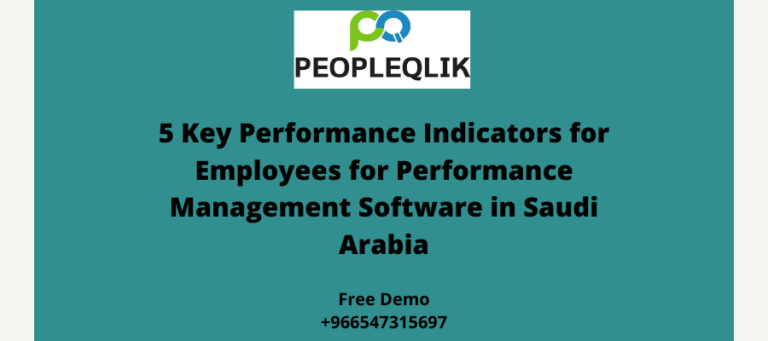PeopleQlik #1 Performance management software in Saudi Arabia Employee key performance indicators (KPIs) are used to measure job performance and assess individual success in relation to company-wide and departmental goals. KPIs are quick indicators of where performance is at its best and where support is required. Leadership can use performance management software to set and track goals for every employee, which are known as key performance indicators (KPIs).
PeopleQlik #1 Performance management software in Saudi Arabia

What are the key performance indicators that employees should be measuring?
Managers can unlock valuable insights into employee performance and productivity by setting and tracking KPIs. KPIs can help you identify strengths of employees and create strategies that deliver results. KPIs can be adjusted and monitored to see if teams are meeting their goals. The insights gained from setting and tracking KPIs have an effect across the business: they inform strategies from recruiting to sales to marketing, give everyone a realistic picture of output and achievements, and help guide individual performance goals.
Key performance indicators for employees are a huge benefit to the whole organization.
- Transparency around real efficiency, output
- Set realistic goals and measure success at both the individual and corporate levels.
- Performance insight is needed to identify A Players as well as growth opportunities
- Leadership should be able to adapt expectations to trends and patterns.
- Engage and motivate employees to achieve their highest potential with clearly defined, achievable goals
Here are five examples of key performance indicators for employees:
While key performance management software in Saudi Arabia for employees can vary by industry and role, they all measure whether the goals were achieved, exceeded or failed to meet. Effective KPIs are aligned with departmental and business goals, but can be adjusted depending on the definition of success at your company.
These five KPIs provide an enhanced understanding of employee performance and individual performance.
1. A financial KPI: Quarterly sales goals or money saved through employee retention
Sales teams that generate revenue have simple financial key performance indicators such as quarterly and annual sales. If the sales team fails to meet their KPIs the leadership can identify if any one person is behind, or if the overall sales numbers are falling and then address the problem. HR departments might establish goals to reduce onboarding and hiring costs. They can also track their progress and make adjustments if necessary.
2. A productivity KPI is the number of tickets produced or the number of parts manufactured
Key performance indicators for productivity give managers a quick overview of team and individual output. They also allow them to determine who is under-performing and who is over-performing. Managers can track key performance indicators for customer service teams, such as the number and quality of tickets or calls that were answered. Manufacturing plants can keep track of the number and type of parts that are completed by each employee. Regularly tracking productivity KPIs allows managers to adjust KPIs in response to seasonality and changes in team size.
3. A customer KPI is the customer retention rate or repeat site visitors
It is easy to track customer KPIs and determine whether customer-facing strategies are working. To determine if their digital marketing strategies work, marketing teams will look at metrics such as the number of customers who return to the site and the open rate for customer emails. Customer service and sales teams can monitor customer satisfaction by sending out satisfaction surveys to customers after they have placed an order. Retention rate is another useful metric since acquiring new customers is as much as five times more expensive than retaining your existing customers in Performance management software in Saudi Arabia. When employees improve one of these customer KPIs, like increasing the average customer satisfaction score or click-through rate in customer emails, you can recognize their success and include achievements in their performance reviews.
4. A people KPI: Employee engagement score or retention rate
Just like customer experience determines their retention and satisfaction levels, employee experience determines theirs. Monitoring employee engagement and implementing a regular performance review process, like with performance management software, can help you identify excellent employees, as well as those who are at risk of quitting or need additional training. You can get a complete picture of employee engagement and productivity by setting clear goals and measuring their performance and regularly checking in with them. Key performance indicators, which look at both employee feedback as well as performance, can help you create a more positive employee experience and encourage a motivated workforce.
5. A time-based KPI is: Reduced hold time, quicker call resolution or log extra hours
Key performance indicators that are time-based show when a process is more efficient or problems are solved more quickly. Time-based KPIs can be used by customer support teams to track efficiency for both individuals and teams. Management can track customer wait times and the average time it takes to resolve customer issues. This helps them set realistic expectations and focuses on customer service. Managers can also track overtime hours to determine if their output expectations are reasonable or if they should adjust.
KPIs provide insight into employee productivity, efficiency, and engagement. KPIs provide managers with a framework to address successes and challenges in performance evaluations. KPIs can be a great way to establish clear and achievable goals, and track each individual’s growth and output. Following an especially tumultuous year, it’s essential to develop a performance management system in Saudi Arabia that centers your people, prioritizes transparency, and recognizes their achievements.
Performance management software in Saudi Arabia in Mecca, Medina, Riyadh, Khamis Mushait, Yanbu, Jeddah, Dammam, Unaizah, Uqair, Ha’il, Ta if, Al Bahah, Dhahran, King Abdullah Economic City, Najran, Diriyah, Qatif, Khafji, Jubail, Abqaiq, List of Cities and Towns in Saudi Arabia, Ras Tanura, Turubah, Jazan Economic City, Knowledge Economic City, Medina, Khobar, Abha, Tabuk, Saudi Arabia,
Call us at +966547315697 or contact sales@bilytica.com for a demo. The Performance management Software in the Saudi Arabia team will be happy to serve you.
We also provide
Performance manageemnt software in Saudi Arabia services solutions company in Hafar Al-Batin, Udhailiyah, Al-Awamiyah, Hofuf, Hautat Sudair, Buraidah, Tayma, Duba, ‘uyayna, Saihat, Al-Kharj, Al-ula, Jizan, Rumailah, Ar Rass, Arar, Shaybah, Al Majma’ah, Rabigh, Dhurma, Haradh, List of Saudi Cities by Gdp Per Capita, Badr, Sudair Industrial City, Baljurashi, Shaqraa, Al-Khutt, Habala, Ad Dawadimi, Dawadmi, Layla,
Payroll software in Saudi Arabia in Haql, Afif, Al-Abwa, Farasan, Al-Jaroudiya, Thadig, Al-Thuqbah, Al Wajh, Almardmah, Al-Zilfi, Muzahmiyya, Prince Abdul Aziz Bin Mousaed Economic City, Tharmada’a, Skaka, Um Al-Sahek, Sharurah, Tanomah, Bisha, Dahaban, Al Qunfudhah, Qurayyat, Saudi Arabia, Ha’ir, as Sulayyil, Al Lith, Turaif, Al-Gway’iyyah, Samtah, Wadi Ad-Dawasir, Az Zaimah, Safwa City, Jalajil, Harmah, Mastoorah, Hotat Bani Tamim, Jabal Umm Al Ru’us, Rafha, Qaisumah, Al-Ghat, Hajrah, Al-Hareeq. Excerpt: Jeddah (also spelled Jiddah, Jidda, or Jedda; Arabic: Jidda) is a Saudi Arabian city located on the coast of the Red Sea and is the major urban center of western Saudi Arabia.
Click to Start Whatsapp Chatbot with Sales
Mobile: +966547315697
Email: sales@bilytica.com
HR Solution in Saudi Arabia
HR Software in Saudi Arabia
Benefits Of HR Management in Saudi Arabia
HR Software in Saudi Arabia
HRIS Software in Saudi Arabia



